Marion County, Iowa
Marion County is a county in the U.S. state of Iowa. As of the 2020 census, the population was 33,414.[1] The county seat is Knoxville.[2] It is named for Francis Marion, a brigadier general from South Carolina in the American Revolutionary War.[3]
Marion County | |
|---|---|
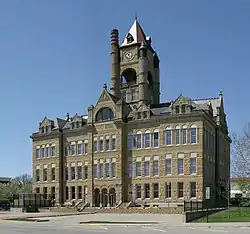 Marion County Courthouse in Knoxville | |
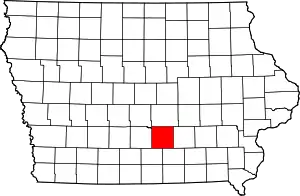 Location within the U.S. state of Iowa | |
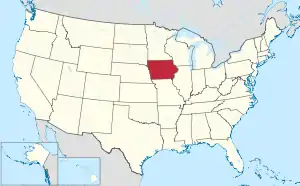 Iowa's location within the U.S. | |
| Coordinates: 41°19′52″N 93°06′08″W | |
| Country | |
| State | |
| Founded | 1845 |
| Named for | Francis Marion |
| Seat | Knoxville |
| Largest city | Pella |
| Area | |
| • Total | 571 sq mi (1,480 km2) |
| • Land | 555 sq mi (1,440 km2) |
| • Water | 16 sq mi (40 km2) 2.8% |
| Population (2020) | |
| • Total | 33,414 |
| • Density | 59/sq mi (23/km2) |
| Time zone | UTC−6 (Central) |
| • Summer (DST) | UTC−5 (CDT) |
| Congressional district | 2nd |
| Website | www |
Geography
According to the U.S. Census Bureau, the county has a total area of 571 square miles (1,480 km2), of which 555 square miles (1,440 km2) is land and 16 square miles (41 km2) (2.8%) is water.[4]
Major highways
Adjacent counties
- Jasper County (north)
- Mahaska County (east)
- Monroe County (southeast)
- Lucas County (southwest)
- Warren County (west)
Demographics
| Census | Pop. | Note | %± |
|---|---|---|---|
| 1850 | 5,482 | — | |
| 1860 | 16,813 | 206.7% | |
| 1870 | 24,436 | 45.3% | |
| 1880 | 25,111 | 2.8% | |
| 1890 | 23,058 | −8.2% | |
| 1900 | 24,159 | 4.8% | |
| 1910 | 22,995 | −4.8% | |
| 1920 | 24,957 | 8.5% | |
| 1930 | 25,727 | 3.1% | |
| 1940 | 27,019 | 5.0% | |
| 1950 | 25,930 | −4.0% | |
| 1960 | 25,886 | −0.2% | |
| 1970 | 26,352 | 1.8% | |
| 1980 | 29,669 | 12.6% | |
| 1990 | 30,001 | 1.1% | |
| 2000 | 32,052 | 6.8% | |
| 2010 | 33,309 | 3.9% | |
| 2020 | 33,414 | 0.3% | |
| U.S. Decennial Census[5] 1790-1960[6] 1900-1990[7] 1990-2000[8] 2010-2018[9] | |||

2020 census
The 2020 census recorded a population of 33,414 in the county, with a population density of 58.4743/sq mi (22.5770/km2). 96.24% of the population reported being of one race. 91.15% were non-Hispanic White, 0.87% were Black, 2.09% were Hispanic, 0.21% were Native American, 1.20% were Asian, 0.06% were Native Hawaiian or Pacific Islander and 4.41% were some other race or more than one race. There were 14,073 housing units, of which 13,145 were occupied.[1]
2010 census
The 2010 census recorded a population of 33,309 in the county, with a population density of 60.1018/sq mi (23.2054/km2). There were 13,914 housing units, of which 12,723 were occupied.[10]
2000 census
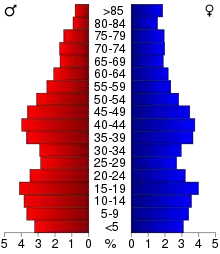
As of the census[11] of 2000, there were 32,052 people, 12,017 households, and 8,532 families residing in the county. The population density was 58 people per square mile (22 people/km2). There were 12,755 housing units at an average density of 23 units per square mile (8.9 units/km2). The racial makeup of the county was 97.46% White, 0.42% Black or African American, 0.19% Native American, 1.03% Asian, 0.04% Pacific Islander, 0.22% from other races, and 0.64% from two or more races. 0.80% of the population were Hispanic or Latino of any race.
There were 12,017 households, out of which 33.00% had children under the age of 18 living with them, 61.20% were married couples living together, 6.90% had a female householder with no husband present, and 29.00% were non-families. 25.60% of all households were made up of individuals, and 11.90% had someone living alone who was 65 years of age or older. The average household size was 2.50 and the average family size was 3.02.
In the county, the population was spread out, with 25.30% under the age of 18, 10.20% from 18 to 24, 26.50% from 25 to 44, 22.10% from 45 to 64, and 15.90% who were 65 years of age or older. The median age was 37 years. For every 100 females there were 98.60 males. For every 100 females age 18 and over, there were 95.80 males.
The median income for a household in the county was $42,401, and the median income for a family was $50,052. Males had a median income of $36,460 versus $25,573 for females. The per capita income for the county was $18,717. About 5.20% of families and 7.60% of the population were below the poverty line, including 8.70% of those under age 18 and 10.80% of those age 65 or over.
Communities
Townships
- Clay
- Dallas
- Franklin
- Indiana
- Knoxville
- Lake Prairie
- Liberty
- Pleasant Grove
- Red Rock
- Summit
- Union
- Washington
Population ranking
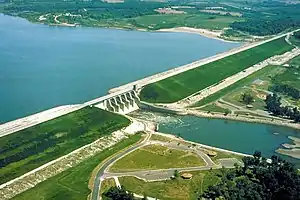
The population ranking of the following table is based on the 2020 census of Marion County.[1]
† county seat
| Rank | City/Town/etc. | Municipal type | Population (2020 Census) |
|---|---|---|---|
| 1 | Pella | City | 10,464 |
| 2 | † Knoxville | City | 7,595 |
| 3 | Pleasantville | City | 1,676 |
| 4 | Melcher-Dallas | City | 1,195 |
| 5 | Bussey | City | 387 |
| 6 | Harvey | City | 236 |
| 7 | Hamilton | City | 119 |
| 8 | Swan | City | 76 |
| 9 | Marysville | City | 44 |
Gallery
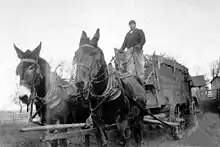 Marion County farmer with mule-drawn wagon, about 1926
Marion County farmer with mule-drawn wagon, about 1926 Two Iowa farm boys riding a pony, about 1937
Two Iowa farm boys riding a pony, about 1937 Iowa farm boy riding hog, about 1941
Iowa farm boy riding hog, about 1941 Farm house and barn yard near Pleasantville, 1957
Farm house and barn yard near Pleasantville, 1957 Cows in farm pasture, 1957
Cows in farm pasture, 1957 Farmer getting coal, December 1957
Farmer getting coal, December 1957 Farm barnyard
Farm barnyard Farm barnyard and silo, 1960
Farm barnyard and silo, 1960
Politics
| Year | Republican | Democratic | Third party | |||
|---|---|---|---|---|---|---|
| No. | % | No. | % | No. | % | |
| 2020 | 12,663 | 65.84% | 6,178 | 32.12% | 391 | 2.03% |
| 2016 | 10,962 | 61.53% | 5,482 | 30.77% | 1,372 | 7.70% |
| 2012 | 9,828 | 55.57% | 7,507 | 42.44% | 352 | 1.99% |
| 2008 | 9,256 | 54.34% | 7,421 | 43.57% | 355 | 2.08% |
| 2004 | 9,990 | 59.83% | 6,574 | 39.37% | 132 | 0.79% |
| 2000 | 8,358 | 58.01% | 5,741 | 39.85% | 309 | 2.14% |
| 1996 | 6,100 | 46.74% | 5,978 | 45.80% | 974 | 7.46% |
| 1992 | 6,062 | 44.79% | 5,531 | 40.87% | 1,940 | 14.34% |
| 1988 | 5,914 | 45.65% | 6,922 | 53.44% | 118 | 0.91% |
| 1984 | 7,259 | 53.24% | 6,313 | 46.30% | 62 | 0.45% |
| 1980 | 6,665 | 49.30% | 5,490 | 40.61% | 1,363 | 10.08% |
| 1976 | 5,429 | 45.79% | 6,226 | 52.51% | 202 | 1.70% |
| 1972 | 6,583 | 57.09% | 4,643 | 40.27% | 305 | 2.65% |
| 1968 | 5,791 | 52.35% | 4,618 | 41.75% | 653 | 5.90% |
| 1964 | 3,903 | 32.96% | 7,911 | 66.80% | 28 | 0.24% |
| 1960 | 7,444 | 61.99% | 4,547 | 37.87% | 17 | 0.14% |
| 1956 | 6,830 | 56.13% | 5,316 | 43.69% | 22 | 0.18% |
| 1952 | 7,165 | 57.25% | 5,196 | 41.51% | 155 | 1.24% |
| 1948 | 4,312 | 39.67% | 6,300 | 57.96% | 258 | 2.37% |
| 1944 | 4,874 | 42.99% | 6,365 | 56.14% | 99 | 0.87% |
| 1940 | 5,763 | 45.19% | 6,915 | 54.22% | 75 | 0.59% |
| 1936 | 4,975 | 41.51% | 6,745 | 56.27% | 266 | 2.22% |
| 1932 | 3,695 | 33.49% | 7,067 | 64.05% | 272 | 2.47% |
| 1928 | 6,225 | 59.36% | 4,113 | 39.22% | 149 | 1.42% |
| 1924 | 5,058 | 47.65% | 2,383 | 22.45% | 3,174 | 29.90% |
| 1920 | 5,435 | 56.62% | 3,861 | 40.22% | 303 | 3.16% |
| 1916 | 2,459 | 42.90% | 3,094 | 53.98% | 179 | 3.12% |
| 1912 | 1,191 | 22.66% | 2,276 | 43.31% | 1,788 | 34.02% |
| 1908 | 2,625 | 46.12% | 2,739 | 48.12% | 328 | 5.76% |
| 1904 | 2,988 | 53.05% | 2,202 | 39.10% | 442 | 7.85% |
| 1900 | 2,950 | 48.53% | 2,950 | 48.53% | 179 | 2.94% |
| 1896 | 2,741 | 46.05% | 3,119 | 52.40% | 92 | 1.55% |
| 1892 | 2,319 | 43.70% | 2,540 | 47.86% | 448 | 8.44% |
| 1888 | 2,374 | 47.30% | 2,322 | 46.26% | 323 | 6.44% |
| 1884 | 2,356 | 47.27% | 2,593 | 52.03% | 35 | 0.70% |
| 1880 | 2,452 | 47.46% | 1,520 | 29.42% | 1,194 | 23.11% |
References
- "2020 Census State Redistricting Data". census.gov. United states Census Bureau. Retrieved August 12, 2021.
- "Find a County". National Association of Counties. Retrieved June 7, 2011.
- Gannett, Henry (1905). The Origin of Certain Place Names in the United States. U.S. Government Printing Office. p. 200.
- "US Gazetteer files: 2010, 2000, and 1990". United States Census Bureau. February 12, 2011. Retrieved April 23, 2011.
- "U.S. Decennial Census". United States Census Bureau. Retrieved July 20, 2014.
- "Historical Census Browser". University of Virginia Library. Retrieved July 20, 2014.
- "Population of Counties by Decennial Census: 1900 to 1990". United States Census Bureau. Retrieved July 20, 2014.
- "Census 2000 PHC-T-4. Ranking Tables for Counties: 1990 and 2000" (PDF). United States Census Bureau. Archived (PDF) from the original on March 27, 2010. Retrieved July 20, 2014.
- "State & County QuickFacts". United States Census Bureau. Archived from the original on June 7, 2011. Retrieved July 20, 2014.
- "Population & Housing Occupancy Status 2010" (PDF). United States Census Bureau American FactFinder. Archived (PDF) from the original on October 16, 2020. Retrieved August 15, 2022.
- "U.S. Census website". United States Census Bureau. Retrieved January 31, 2008.
- Leip, David. "Dave Leip's Atlas of U.S. Presidential Elections". uselectionatlas.org. Retrieved April 27, 2018.